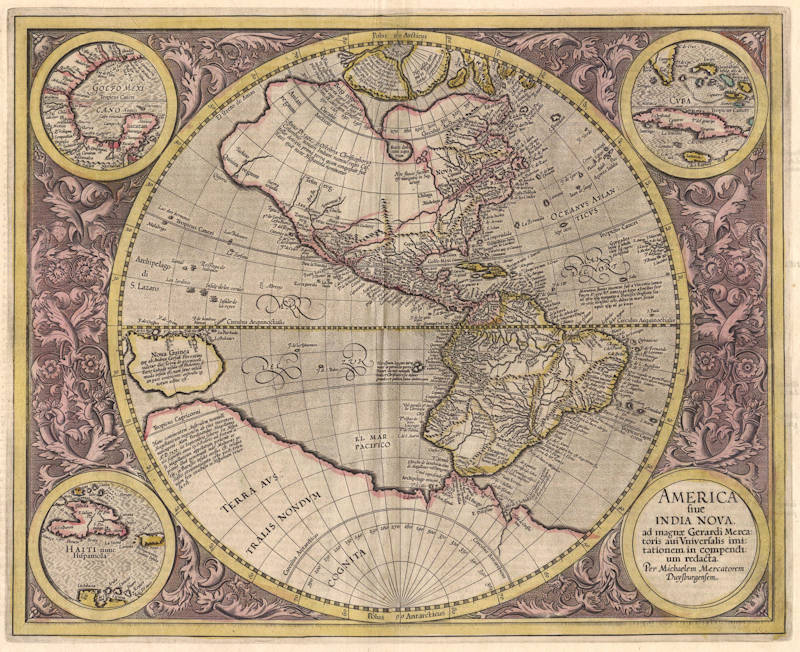Leen Helmink Antique Maps & Atlases
www.helmink.com
Mercator
America sive India Nova
Certificate of Authentication and Description
This is to certify that the item illustrated and described below is a genuine antique
map, print or book that was first produced and published in 1595, today 430 years ago.
December 28, 2025
Cartographer(s)
Mercator
First Published
Duisburg, 1595
This edition
1628 French
Size
36.6 x 46.1 cms
Technique
Copper engraving
Stock number
18654
Condition
mint


Description
"After the death of the great Gerard Mercator in 1594 it was left to his son Rumold to publish the last of three parts that formed his famous atlas, the 'Atlantis Pars Altera'. The atlas was finished with a number of maps engraved by various descendants of Gerard. The task of the American maps was given to his grandson Michael. The only printed map known to be by him, it is beautifully engraved. It is not well known that he was the engraver of the famous Drake silver medal of 1589. At that time he was resident in London.
It is a hemispherical map contained within an attractive floral design, and surrounded by four roundels, one of which contains the title. The other three contain maps of the Gulf of Mexico, Cuba and Hispaniola, all spheres of Spanish influence. The general outline is largely taken from Rumold Mercator's world map of 1587, with a little more detail added. A few of the most famous theories are still present: a large inland lake in Canada, two of the four islands of the North Pole [...], a bulge to the west coast of South America and the large southern continent. It does not show any knowledge of the English in Virginia, which is possibly a reflection of their failure by then. A large St. Lawrence River is shown originating half way across the continent."
(Burden).
"The representation of America is fairly conventional for large-scale maps of this period, and the marginal insets add a touch of welcome detail. Note that New Guinea is on the same meridian as Alaska."
(Portinaro).
Gerard Mercator (Kremer) 1512-1594
Arnold Mercator (son) 1537–1587
Rumold Mercator (son) c. 1545– c. 1599
Bartholomeus Mercator (son) fl. 1540-1563
Gerard Mercator (grandson) c. 1563-1656
Joannes Mercator (grandson) c. 1562-1595
Michael Mercator (grandson) c. 1567–1600
For nearly sixty years, during the most important and exciting period in the story of modern map making, Gerard Mercator was the supreme cartographer, his name, second only to Ptolemy, synonymous with the form of map projection still in use today. Although not the inventor of this type of projection he was the first to apply it to navigational charts in such a form that compass bearings could be plotted on charts in straight lines, thereby providing seamen with a solution to an age-old problem of navigation at sea.
His influence transformed land surveying and his researches and calculations led him to break away from Ptolemy conception of the size and outline of the Continents, Drastically reducing the longitudinal length of Europe and Asia and altering the shape of the Old World as visualized in the early sixteenth century.
Mercator was born in Rupelmonde in Flanders and studied in Louvain under Gemma Frisius, Dutch writer, astronomer and mathematician. He established himself there as a cartographer and instrument and globe maker, and when he was twenty-five drew and engraved his first map (of Palestine) and went on to produce a map of Flanders (1540) supervising the surveying and completing the drafting and engraving himself.
The excellence of his work brought him the patronage of Charles V for whom he constructed a globe, but in spite of his favour with the Emperor he was caught up in the persecution of Lutheran protestants and charged with heresy, fortunately without serious consequences. No doubt the fear of further persecution influenced his move in 15 s 2 to Duisburg, where he continued the production of maps, globes and instruments culminating in large-scale maps Europe (1954), the British Isles (1564) and the famous World Map on 18 sheets drawn to his new projection (1969). All these early maps are exceedingly rare, some being known by only one copy.
In later life he devoted himself to his edition of the maps in Ptolemy's Geographia, reproduced in his own engraving as nearly as possible in their original form, and to the preparation of his 3-volume collection of maps to which, for the first time, the word 'Atlas' was applied. The word was chosen, he wrote, 'to honour the Titan, Atlas, King of Mauritania, a learned philosopher, mathematician and astronomer'. The first two parts of the Atlas were published in 1583 and 1589 and the third, with the first two making a complete edition, in 1595, the year after Mercator's death.
Mercator's sons and grandsons, named above, were all cartographers and made their contributions in various ways to the great atlas. Rumold, in particular, was responsible for the complete edition in 1595. After a second complete edition in 1602, the map plates were bought in 1604 by Jodocus Hondius who, with his sons, Jodocus II and Henricus, published enlarged editions which dominated the map market for the following twenty to thirty years.
(Moreland & Bannister).